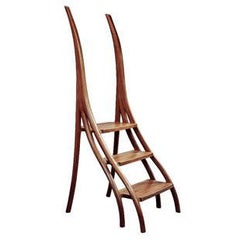David N Ebner Library Steps
21st Century and Contemporary American American Craftsman Ladders
Walnut
People Also Browsed
Vintage 1970s Swedish Scandinavian Modern Candlesticks
Brass
Early 20th Century American Art Nouveau Patio and Garden Furniture
Iron
Early 20th Century English Georgian Chairs
Brass
Antique Late 19th Century English Ladders
Brass
21st Century and Contemporary European Modern Dining Room Tables
Stone, Travertine
Vintage 1960s Mexican Modern Tables
Gold Leaf
Early 20th Century Czech Art Nouveau Glass
Blown Glass
Antique Early 1900s Czech Art Nouveau Table Clocks and Desk Clocks
Brass
Antique 19th Century Italian Baroque Rocking Chairs
Silver Leaf
20th Century Art Nouveau Table Lamps
Art Glass
Early 20th Century American Art Nouveau Table Mirrors
Bronze
Antique 1890s English Neoclassical Dinner Plates
Porcelain
Vintage 1940s American Art Deco Musical Instruments
Chrome
Antique Late 18th Century English Chippendale Drop-leaf and Pembroke Tables
Mahogany
Vintage 1930s American Stairs
Iron
Antique Early 1900s French Art Nouveau Armchairs
Walnut
David N. Ebner for sale on 1stDibs
Master woodworker David N. Ebner is an integral contributor to the American Studio furniture movement. Along with like-minded artisans such as George Nakashima, Sam Maloof, Arthur Espenet Carpenter and Wharton Esherick, the New York native advocates for the craft of well-made furniture that is not mass-produced. As Ebner himself has stated, “[I am] creating the antiques of tomorrow.”
Ebner was born in 1945 in Buffalo and attended the School for American Craftsmen at the Rochester Institute of Technology. There, he studied under celebrated American furniture maker Wendell Castle who taught Ebner “the artistic approach” to woodworking. After graduating, Ebner sought to further his education at the London School of Furniture Making. Then, following a two-year stint in the US Armed Forces, he decided to pursue a career as a woodworker and furniture designer, opening a studio on Long Island, New York, in 1973.
As a devotee of Castle’s teachings of creating furniture as a form of functional art, Ebner eschewed the trend of making furniture out of plastics and other synthetic materials — which gained steam with the likes of venturesome Scandinavian modernist designer Verner Panton during the 1960s and 1970s — embracing instead the American Craftsman style that formed the basis of the American Studio furniture movement.
Working with a range of woods, Ebner has designed sculptural live-edge dining room tables, shapely bamboo stools and side tables characterized by swooping organic curves, and statement-making cabinets in lustrous sapele wood, each elegantly hand-carved. “... Each piece is treated as an art object with concern for my material and honesty to its inherent qualities,” Ebner has said. “For me, one’s creative ability is demonstrated in the diversity of the pieces and what one learns from change.”
Ebner has exhibited extensively throughout his career, including shows at the American Crafts Museum and Cooper Hewitt, Smithsonian Design Museum in New York, the deCordova Sculpture Park and Museum in Lincoln, Massachusetts, and the Guild Hall Museum in East Hampton. His works are in permanent collections at the Smithsonian Institute, the Museum of Fine Arts in Boston and the Art Institute of Chicago.
Find vintage David N. Ebner chairs, tables, benches and decorative objects on 1stDibs.
Finding the Right Ladders for You
Vintage, new and antique ladders are not only a must-have structure designed to safely reach higher places in your kitchen and the rest of your space. A ladder can also be repurposed as a decorative home accent for use in nearly any room in your home.
While the exact date that ladders were invented is unclear, a painting of a crude ladder that is believed to be more than 10,000 years old was uncovered in a cave in Spain.
Ladders have taken on all forms over the years to meet certain needs. Rope ladders have come into use for emergency rescues by air and sea, extendable ladders are still pivotal to the dangerous work that firefighters do daily, and stepladders are a big part of getting you where you need to go at home.
Antique ladders can be found in a variety of styles and materials. You can occasionally find a modest-sized antique stepladder, perhaps designed in the neoclassical style, that may have been for library use and resembles a short staircase with small drawers built into the front and the sides of the steps. On 1stDibs, browse a collection of wood ladders and metal ladders that were crafted in the modern, Georgian, Victorian and other styles.
Decorating with an old farmhouse ladder can give it a new purpose and also breathe a bit of life into a dining room, living room or mudroom. For those drawn to the warmth and coziness that farmhouse-style furniture and decor can bring into a space — which usually refers to an amalgam of other rustically rooted styles, such as cottage, French country and industrial — an antique farmhouse ladder can serve a functional purpose as well as meet your needs to dress up a space with creative flourishes.
Lean your wood ladder up against a wall and use its rungs to display your treasured mid-century modern textiles, rare books or potted plants. Drape your patterned dish towels over the ladder steps for easy access as well as to make sure your towels are clean and dry for the next round of dishes. Get some help to properly suspend your farmhouse ladder from the ceiling above your rustic farm dining table and hang your antique lanterns from its rungs and sides for a welcome experience at mealtime.
On 1stDibs, find an extensive collection of antique, new and vintage ladders today.
